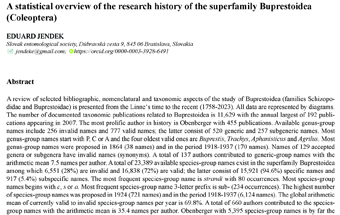Abstract
A review of selected bibliographic, nomenclatural and taxonomic aspects of the study of Buprestoidea (families Schizopodidae and Buprestoidae) is presented from the Linne‘s time to the recent (1758-2023). All data are represented by diagrams. The number of documented taxonomic publications related to Buprestoidea is 11,629 with the annual largest of 192 publications appearing in 2007. The most prolific author in history is Obenberger with 455 publications. Available genus-group names include 256 invalid names and 777 valid names; the latter consist of 520 generic and 257 subgeneric names. Most genus-group names start with P, C or A and the four oldest valid ones are Buprestis, Trachys, Aphanisticus and Agrilus. Most genus-group names were proposed in 1864 (38 names) and in the period 1918-1937 (170 names). Names of 129 accepted genera or subgenera have invalid names (synonyms). A total of 137 authors contributed to generic-group names with the arithmetic mean 7.5 names per author. A total of 23,389 available species-group names exist in the superfamily Buprestoidea among which 6,551 (28%) are invalid and 16,838 (72%) are valid; the latter consist of 15,921 (94.6%) specific names and 917 (5.4%) subspecific names. The most frequent species-group name is strandi with 80 occurrences. Most species-group names begins with c, s or a. Most frequent species-group name 3-letter prefix is sub- (234 occurrences). The highest number of species-group names was proposed in 1924 (721 names) and in the period 1918-1937 (6,124 names). The global arithmetic mean of currently valid to invalid species-group names per year is 69.8%. A total of 660 authors contributed to the species-group names with the arithmetic mean is 35.4 names per author. Obenberger with 5,395 species-group names is by far the most prolific author. The subfamily Agrilinae has most genera (205, 39.4% of valid genera of Buprestoidea). Two tribes with the largest number of genera are also from subfamily Agrilinae: Coraebini (131 genera) and Agrilini (44 genera). Among 520 accepted genera of Buprestoidea, 71 (13.6%) have subgenera. The superfamily Buprestoidea contains 15,921 accepted species, among which seven belong to the family Schizopodidae and the rest to the family Buprestidae. Almost half (7,282, 45.8%) of all species of Buprestoidea is from the three agriline tribes: Agrilini, Tracheini and Coraebini. The most speciose genus in Buprestoidea, and in the whole of Animalia, is Agrilus (3,431 species), followed by Sphenoptera (1,002). Chrysochroa fulminans (Fabricius, 1787) is the jewel beetle species with the highest number of recognized subspecies (18).
References
- Bellamy C. L. 2008a. A world catalogue and bibliography of the jewel beetles (Coleoptera: Buprestoidea). Volume 1, Introduction, Fossil Taxa; Schizopodidae; Buprestidae: Julodinae - Chrysochroinae: Poecilonotini. Sofia, Pensoft, pp. 1–625.
- Bellamy C. L. 2008b. A world catalogue and bibliography of the jewel beetles (Coleoptera: Buprestoidea). Volume 2, Chrysochroinae: Sphenopterini - Buprestinae: Stigmoderini. Sofia, Pensoft, pp. 626–1259.
- Bellamy C. L. 2008c. A world catalogue and bibliography of the jewel beetles (Coleoptera: Buprestoidea). Volume 3, Pterobothrini through Agrilinae: Agrilini: Rhaeboscelina. Sofia, Pensoft, pp. 1260–1931.
- Bellamy C. L. 2008d. A world catalogue and bibliography of the jewel beetles (Coleoptera: Buprestoidea). Volume 4, Agrilinae: Agrilina through Trachyini. Sofia, Pensoft, pp. 1932–2684.
- Bellamy C. L. 2009. A world catalogue and bibliography of the jewel beetles (Coleoptera: Buprestoidea). Volume 5, Appendices, Bibliography, Indices, Errata & Addenda, Epilogue. Sofia, Pensoft, pp. 2685–3264.
- Haack R. A., Jendek E., Liu H., Marchant K. R., Petrice T. R., Poland T. M. & Ye H. 2002. The emerald ash borer: a new exotic pest in North America. Newsletter of the Michigan Entomological Society 47(3–4): 1–5.
- ICZN (International Commission on Zoological Nomenclature) 1999. International Code of Zoological Nomenclature. Fourth Edition, adopted by the International Union of Biological Sciences. London, International Trust for Zoological Nomenclature, XXIX + 306 pp.
- Jendek E. & Grebennikov V. 2023. Summary of native geographic distribution of all 3,341 species of the most speciose animal genus Agrilus (Coleoptera: Buprestidae). Journal of Insect Biodiversity 39(2): 32–78. https://doi.org/10.12976/jib/2023.39.2.1


